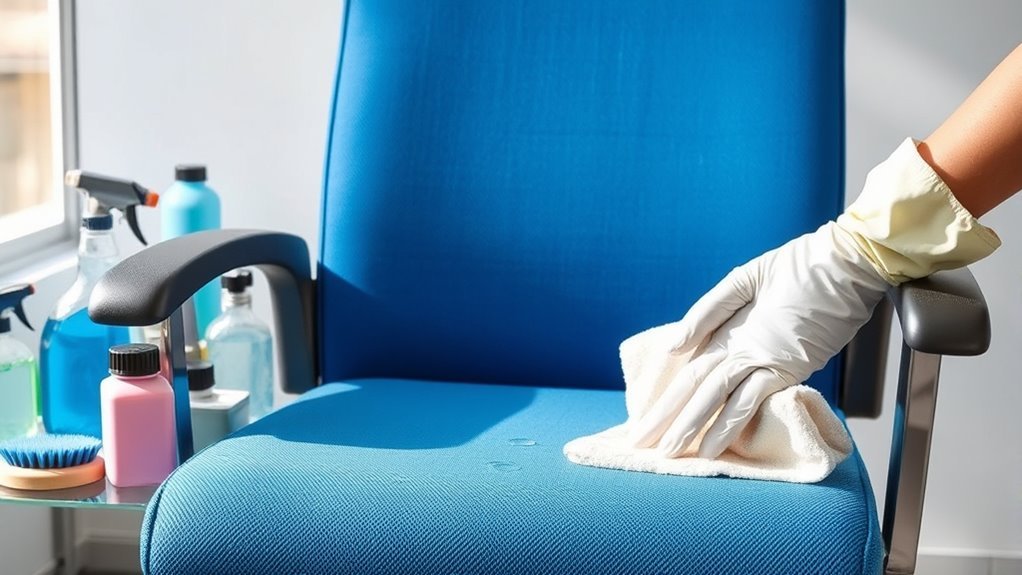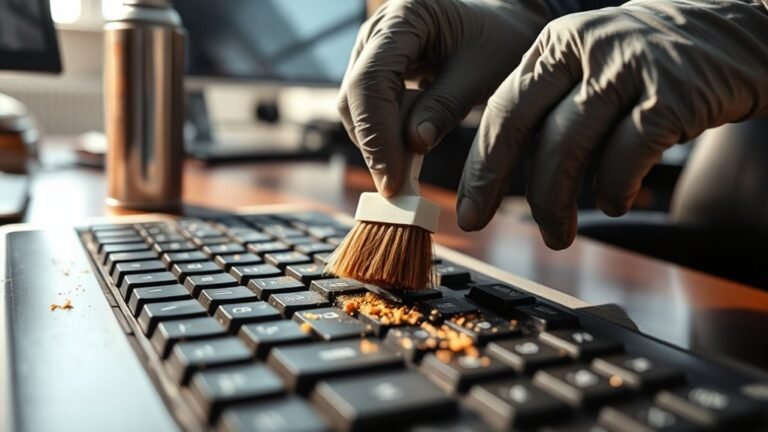Step-By-Step Guide to Cleaning Office Chair
First, identify your chair’s material to choose safe cleaners. Gather supplies like a vacuum with upholstery attachment, microfiber cloths, and fabric-specific cleaners. Start by vacuuming loose dirt and debris, especially in crevices. Next, spot clean stains using gentle, tested solutions. For deep cleaning, use mild soap on mesh or leather cleaners for leather chairs. Finally, air-dry your chair thoroughly in shade and maintain it regularly to extend its life. Following these steps guarantees a refreshed, long-lasting chair—explore further for tailored fabric care.
Assessing the Material of Your Office Chair

How do you determine the best cleaning approach for your office chair? Start by identifying the fabric types and understanding their material durability. Different fabrics—such as mesh, leather, or synthetic blends—react uniquely to cleaning agents and techniques. For instance, leather requires gentle, non-abrasive cleaners to maintain its integrity, while mesh can tolerate mild detergents but needs careful drying to avoid damage. Assess the chair’s tags or manufacturer guidelines to confirm fabric composition. Consider the material durability to prevent deterioration during cleaning; more delicate fabrics demand softer methods, whereas robust materials allow for more rigorous cleaning. By methodically evaluating these factors, you’ll select a cleaning strategy that preserves your chair’s appearance and longevity, giving you the freedom to maintain a fresh, comfortable workspace without hesitation.
Gathering Cleaning Supplies
Once you’ve identified the fabric and durability of your office chair, the next step is to gather the appropriate cleaning supplies tailored to those materials. Start by preparing a supply checklist that includes essential cleaning tools such as a soft-bristle brush, microfiber cloths, a vacuum with upholstery attachment, and mild cleaning agents suitable for your chair’s fabric. For leather chairs, include a specialized leather cleaner and conditioner. For synthetic fabrics, a gentle detergent diluted in water works well. Avoid harsh chemicals that could damage the material. Having all necessary cleaning tools organized before you begin guarantees an efficient process and protects your freedom to maintain your workspace on your terms. This methodical approach will save time and prevent interruptions during the cleaning session.
Removing Loose Debris and Dust

Before you start wiping down your office chair, it’s important to remove any loose debris and dust that can interfere with deeper cleaning. Use a vacuum with a brush attachment to carefully clean the fabric and tight crevices where dirt tends to accumulate. For hard-to-reach areas, compressed air can effectively dislodge particles without damaging delicate components.
Vacuuming Fabric and Crevices
Start by using a vacuum cleaner with a brush attachment to thoroughly remove loose debris and dust from the fabric and crevices of your office chair. Focus on every nook, including seams and under cushions, where dirt often hides. Employ vacuuming techniques that emphasize slow, deliberate strokes to lift particles without damaging the upholstery. For effective upholstery maintenance, adjust suction power to suit fabric delicacy, preventing wear while ensuring cleanliness. Pay special attention to areas prone to buildup, like the seat and backrest edges. Regular vacuuming not only preserves your chair’s appearance but also extends its lifespan, giving you the freedom to enjoy a clean, inviting workspace. This methodical approach guarantees a deep clean, setting the foundation for subsequent cleaning steps.
Using Compressed Air
Three key areas of your office chair—corners, vents, and intricate crevices—often trap dust and loose debris that vacuuming can miss. Using compressed air is an effective next step to guarantee thorough cleaning. The compressed air benefits include dislodging particles from hard-to-reach spots without damaging delicate components. When using an air duster, hold the can upright and direct short bursts into these tight areas, maintaining a safe distance to avoid moisture buildup. This method frees trapped dust, enhancing both cleanliness and the chair’s longevity. By incorporating compressed air into your routine, you gain greater control over the cleaning process, freeing your workspace from hidden dirt and maintaining a fresh, professional environment effortlessly.
Spot Cleaning Stains and Spills
When you spot a stain or spill on your office chair, first identify the type of stain to choose the most effective cleaner. Always apply the cleaner carefully and remember to blot gently instead of rubbing to avoid damaging the fabric. This method guarantees you tackle the stain efficiently while preserving the chair’s material.
Identify Stain Type
How can you effectively tackle stains on your office chair without causing further damage? Begin by employing stain identification techniques to recognize common stain types. This step guarantees you apply the right cleaning method for each stain, preserving your chair’s material and appearance.
| Stain Type | Characteristics | Common Sources |
|---|---|---|
| Protein-based | Sticky, odor present | Food, sweat |
| Oil-based | Greasy, dark spots | Cooking oil, lotions |
| Dye-based | Vibrant, penetrates fabric | Ink, wine, coffee |
Select Appropriate Cleaner
Since different stains require specific treatments, selecting the appropriate cleaner is essential to effectively removing spots and spills without damaging your office chair’s material. You want a product that’s both effective and safe, respecting your chair’s fabric and your health.
- For fabric chairs, opt for eco friendly cleaners that are gentle yet powerful, avoiding harsh chemicals.
- Leather chairs require specialized commercial cleaners designed to condition and protect.
- For synthetic materials, a mild detergent mixed with water often suffices, but test first in an inconspicuous spot.
- Always check the cleaner’s label for compatibility and follow manufacturer recommendations to maintain your chair’s integrity.
Blot, Don’t Rub
One of the most important steps in spot cleaning stains and spills on your office chair is to blot the affected area rather than rubbing it. Rubbing can spread the stain and damage the fabric fibers, reducing the chair’s lifespan. Use gentle blotting techniques by pressing a clean, absorbent cloth onto the spill, allowing it to soak up the liquid. Repeat this process with fresh sections of the cloth until the stain diminishes. Maintain a consistent cleaning frequency to prevent buildup and make stain removal easier. By incorporating regular blotting into your maintenance routine, you’ll preserve your chair’s appearance and functionality, all while enjoying the freedom of a clean, comfortable workspace. Remember, patience and care in blotting yield the best results.
Deep Cleaning Different Chair Fabrics
Although office chairs come in a variety of fabrics, each material demands a specific cleaning approach to guarantee thorough deep cleaning without damage. Understanding fabric care and appropriate cleaning techniques is key to preserving your chair’s appearance and durability.
- Mesh Fabric: Use a vacuum with a brush attachment to remove debris, then gently scrub with mild soap and water.
- Leather: Apply a leather cleaner or a mixture of vinegar and water; avoid soaking, and wipe dry immediately.
- Velvet or Suede: Use a soft brush to loosen dirt, then spot clean with a specialized fabric cleaner.
- Synthetic Fabrics: These often tolerate stronger detergents, but always test in an inconspicuous spot first.
Following these tailored methods guarantees your chair stays fresh without compromising the fabric’s integrity.
Drying and Maintaining Your Office Chair

After thoroughly cleaning your office chair’s fabric according to its specific needs, the next step is guaranteeing it dries properly and stays well-maintained. Proper drying techniques prevent mold and fabric damage, preserving your chair’s integrity. Allow your chair to air dry in a well-ventilated area away from direct sunlight, which can fade colors. Use a fan to speed up drying without heat.
| Task | Tip |
|---|---|
| Drying Location | Well-ventilated, shaded area |
| Drying Time | Several hours to overnight |
| Maintenance | Regular dusting and vacuuming |
| Fabric Care | Use fabric protectors sparingly |
| Inspection | Check for tears or stains weekly |
Following these steps guarantees your office chair stays fresh and durable, giving you freedom from frequent replacements.
Frequently Asked Questions
How Often Should I Deep Clean My Office Chair?
You should deep clean your office chair every three to six months to keep it in top shape. While weekly cleaning helps maintain its appearance and hygiene, deep cleaning tackles embedded dirt and grime. Incorporate maintenance tips like vacuuming fabric and wiping down hard surfaces regularly. This methodical routine guarantees your chair stays fresh and comfortable, giving you the freedom to focus on work without distractions from a dirty or worn-out seat.
Can Cleaning My Chair Improve My Posture?
Yes, cleaning your chair can indirectly improve your posture benefits by ensuring your office chair remains in peak condition. Regular chair maintenance prevents wear and tear that might compromise support, encouraging proper spinal alignment. By keeping cushions firm, mechanisms smooth, and surfaces clean, you promote comfort and ergonomic support, allowing you to sit correctly. This methodical upkeep not only extends your chair’s life but also supports your freedom to move and sit healthily throughout your day.
Are There Eco-Friendly Cleaning Products Safe for Office Chairs?
Yes, you can definitely find eco-friendly solutions that are safe for cleaning office chairs. Look for biodegradable cleaners made from natural ingredients, which won’t harm your chair’s materials or the environment. These products break down quickly, reducing waste and toxins. When choosing one, check that it’s free from harsh chemicals and fragrances. Using these green options lets you maintain cleanliness while supporting a healthier workspace and planet, giving you the freedom to care responsibly.
How Do I Fix a Broken Office Chair Wheel?
Imagine your chair’s wheel as a tiny but essential cog in the freedom machine of your workspace. For wheel replacement, first flip your chair upside down and remove the broken wheel by pulling it out firmly. Clean the socket to guarantee smooth movement, then press the new wheel in place until it clicks. Regular chair maintenance like this keeps you rolling effortlessly, letting you focus on what really matters without interruptions.
Is Professional Cleaning Necessary for Leather Office Chairs?
You don’t always need professional services for leather office chairs, but they can be invaluable for preserving leather care. If you want to maintain that supple texture and avoid cracking, professionals use specialized cleaners and conditioners you might not have at home. However, with the right products and routine, you can handle basic maintenance yourself, freeing you from frequent costly cleanings while still protecting your chair’s longevity and appearance.






